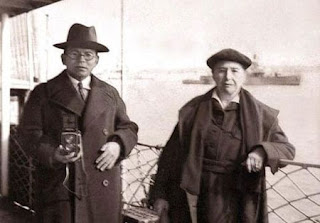Alexandra David-Néel (October 24, 1868 – September 8, 1969) was a Belgian-French explorer, spiritualist, Buddhist and writer most known for her visit to Lhasa, Tibet in 1924, when it was forbidden to foreigners. She wrote over 30 books about Eastern religion, philosophy and her travels. Her teachings influenced beat writers Jack Kerouac and Allen Ginsberg, philosopher Alan Watts and Theosophist Benjamin Creme.
Born Louise Eugénie Alexandrine Marie David in Saint-Mandé, Val-de-Marne, Paris she moved to Ixelles (Brussels) at the age of six. During her childhood she had a very strong desire for freedom and spirituality. At the age of 18, she had already visited England, Switzerland and Spain on her own and was studying in Madame Blavatsky's Theosophical Society.
In 1890 and 1891, she traveled through India, returning only when she was running out of money. In Tunis in 1900 she met and lived with railroad engineer Philippe Néel, marrying him in 1904.
In 1911 Alexandra left Néel and traveled for the second time to India, to further her study of Buddhism. She was invited to the royal monastery of Sikkim, where she met Maharaj Kumar (crown prince) Sidkeong Tulku Namgyal. She became Sidkeong's "confidante and spiritual sister”. She also met the 13th Dalai Lama twice in 1912, and had the opportunity to ask him many questions about Buddhism — a feat unprecedented for a European woman at that time.
From 1914-1916 she lived in a cave in Sikkim, near the Tibetan border, learning spirituality, together with the young Sikkimese monk Aphur Yongden (born 1899). Alhur, who she adopted later, became her lifelong traveling companion. From Sikkim they trespassed into Tibetan territory, meeting the Panchen Lama in Shigatse in August 1916. When the British authorities learned of this (Sikkim was then a British protectorate) Alexandra and Aphur were forced to leave the country. Unable to return to Europe in the middle of World War I, Alexandra and Yongden traveled to Japan.
In Japan Alexandra met Ekai Kawaguchi, who had visited Lhasa in 1901 disguised as a Chinese doctor, and this inspired them to visit Lhasa disguised as pilgrims. After traversing China from east to west, they reached Lhasa in 1924 and spent 2 months there.
In 1928 she legally separated from Philippe, but they continued to exchange letters. He kept supporting her till his death in 1941. Alexandra settled in Digne (Provence), and during the next nine years she wrote books. In 1929, she published her most famous and beloved work, Mystiques et Magiciens du Tibet (Magic and Mystery in Tibet).
In 1937, Alexandra and Yongden went to Tibet through the former Soviet Union, traveling there during World War II. They eventually ended up in Tachienlu, where she continued her investigations of Tibetan sacred literature. While in Eastern Tibet they completed circumambulation of the holy mountain Amnye Machen.
The pair returned to France in 1946. Alexandra was then 78 years old. Yongden died at age 56 in 1955. Alexandra continued to study and write at Digne till her death in Digne-les-Bains at age nearly 101. According to her last will and testament, her ashes and those of Yongden were mixed together and dispersed in the Ganges in 1973 at Varanasi, by her friend Marie-Madeleine Peyronnet.
One minor mystery relating to Alexandra David-Neel has a solution: In Forbidden Journey, p. 284, the authors wonder how Mme. David-Neel's secretary, Violet Sydney, made her way back to the West in 1939 after Sous des nuées d'orage (Storm Clouds) was completed in Tachienlu. Peter Goullart's Land of the Lamas (not in Forbidden Journey's bibliography), on pp. 110–113 gives an account of his accompanying Ms. Sydney partway back, then putting her under the care of Lolo bandits to continue the journey to Chengdu. Mme. David-Neel evidently remained in Tachienlu for the duration of the war.



No comments:
Post a Comment